|
As primates tarsiers are very vocal animals and make a variety of calls. These may be for territorial purposes, a mating call, warning call or an infant’s distress call. Tarsiers will also perform vocal ‘duets’ between mated pairs. There are acoustic differences between the calls of each tarsier species and subspecies and this has been used to help with species identification. There is also evidence that the tarsiers themselves can hear the difference between species and subspecies when played recordings of vocalizations.
Pairs of T. dentatus (Dian’s tarsier), T. tarsier (spectral tarsier) and T. lariang (Lariang tarsier) are known to duet together near their sleeping sites at the end of their night’s activity. In T. tarsier pairs the duets are often started by the female and can last for several minutes. T. pumilus (pygmy tarsier) do not duet and are known to vocalize more rarely than other species. C. bancanus (western tarsier) and C. syrichta (Philippine tarsier) do not perform duets at all and the amount of vocalizations produced varies between sites, with some groups rarely calling. The type of vocalizations produced varies between species – spectral tarsiers have 15 different groups of vocalizations (including alarm calls, food calls, infant calls and play whistles) and the western tarsiers have four groups of vocalizations.
All tarsiers also have scent glands in their face, stomach and genital regions and use scent marking as a form of communication by rubbing their glands of trees, bushes and each other. Tarsiers of all ages urine mark to show their presence. Scent marking may occur more often when females are ready for mating (in oestrus). So far, there has been no research conducted into whether tarsiers recognize the scents of their own species when compared with other species.
Life Cycle
Female Philippine tarsiers have a gestation period of six months and produce one baby per pregnancy, weighing approximately 25g. Mating can take place at any time of the year. Young are born with fur and with their eyes open, can cling to branches within one hour of birth and can leap within one month. Being born at an advanced stage protects them from predators soon after birth. As mammals, tarsiers produce milk to feed their offspring and Philippine tarsiers provide milk for around 60 days, after which the young tarsier moves on to an adult diet. Young Philippine tarsiers become sexually mature at around two years and this species are thought to live up to 20 years in the wild.
Tarsiers do not build nests and mainly carry their young in their mouth or occasionally on their back. Mother tarsiers are known to ‘park’ their offspring in a safe place (usually a tree) nearby to allow them to forage and feed while keeping an eye on the baby. Spectral tarsiers will sometimes groom, play, feed and carry infants of others (known as ‘allocare’) in the wild but this has not been documented in other species or in captivity.
Spectral tarsiers differ from other species by reproducing seasonally with two mating seasons – one between April and June and the other between October and November, with young therefore born in spring/early summer and winter. The average interval between births in wild spectral tarsiers is 13.5 months. Average gestation length in wild spectral tarsiers is slightly longer than Philippine tarsiers at 6.3 months and for the western tarsier is 5.9 months. Western tarsier young move away from their mother at around 10 days old, they can move as an adult at around 22 days and mothers stop carrying their young completely at around 40 days. In captivity western tarsiers have been seen attempting to catch food at 37 days old, but in the wild this has been observed at 26 days old. Western and spectral tarsiers are weaned at around 80 days old. The lifespan of western and spectral tarsiers is thought to be around 16 years in the wild, although exact lifespans are not known.
In captivity tarsiers have shorter lifespans than those proposed for wild tarsiers – T. syrichta are known to survive somewhere between 8 – 12 years in captivity, although one particular animal was thought to have been around 16 years old when she died. The longest lived T. bancanus in captivity survived to around 16 years and for T. spectrum around 12 years. Tarsiers appear to be difficult to care for in captivity and show shorter lifespans than their wild counterparts and this may be due to their need for live food or their shy nature. There is much about the tarsier species which is still unknown and this includes the lifespan of each of the species in the wild.
Diet and Feeding
Tarsiers are the only completely carnivorous primates and have been seen to eat insects, lizards, snakes and birds - leaping through the trees to catch their prey. They are known to leap up to 2m in distance and 1.5m in height. Tarsiers are also known to eat almost every part of their catch including bones and feet. There have been reports of western tarsiers feeding on fruit bats in Borneo, however this is thought to be somewhat unusual and it is thought their diet is most often largely made up of insects. Tarsiers have strong jaws and teeth and have a wide mouth to enable them to feed upon large prey. There have been reports of tarsiers catching birds in flight by leaping from tree to tree and are helped by their adhesive finger pads and specialized legs and feet. Their large eyes and areas help them to locate prey in darkness and they are able to turn their heads almost 360°. Tarsier hearing is so sensitive that they are able to find prey by hearing alone and often close their eyes while catching food, perhaps to protect their large eyes from damage.
In the past it was reported that tarsiers fed on charcoal and burnt logs on the forest floor, however, this was found to be false when it was discovered that they were actually using their long fingers to pick insects from inside the logs. Tarsiers do not survive well in captivity in part due to their specific feeding needs – live food is not permitted in most Zoos and parks and this will impact upon the health and wellbeing of tarsiers in captivity. There is little specifically known about the diet and feeding behavior of each species/subspecies and there may be interesting differences discovered in future.
Continue on page 5
|
|
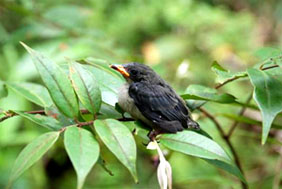
Tarsiers can feed on small birds. © Pierre Fidenci
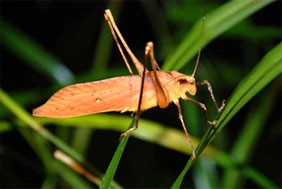
Grasshopper is part of the diet of the Philippine tarsier. © Pierre Fidenci
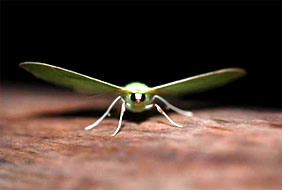
Tarsiers feed heavily on nocturnal insects. © Pierre Fidenci
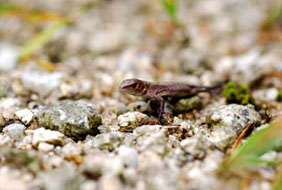
Tarsiers prey on small reptiles like lizards. © Pierre Fidenci
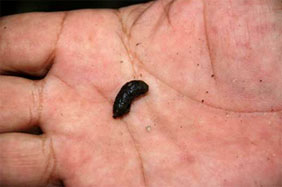
A dung of the Philippine Tarsier found in the field. © Pierre Fidenci
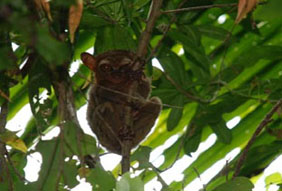
A pregnant Philippine tarsier observed in the field. Tarsier has a gestation period of six months. © Pierre Fidenci
|









